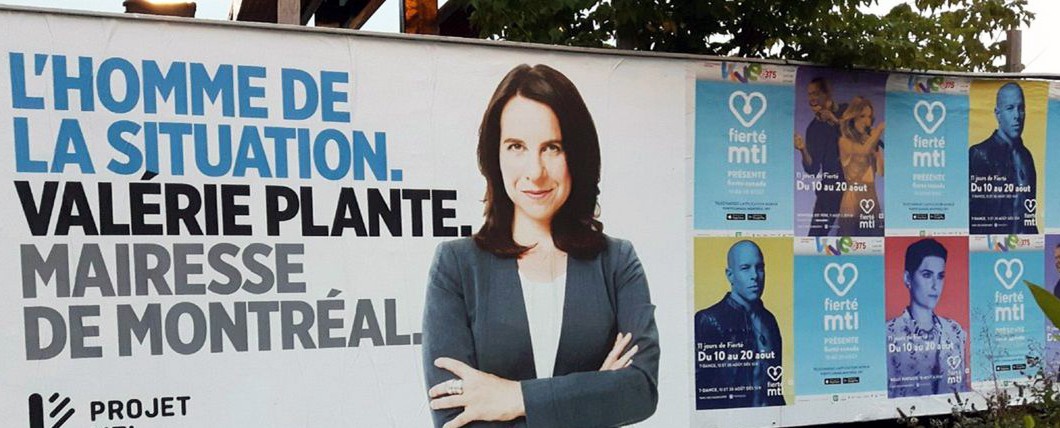Valérie Plante, leader of the Projet Montréal party, has pulled off quite a coup: the campaign hasn’t yet started, but she’s already made a name for herself. When facing an established candidate like current mayor Denis Coderre, who profits from great notoriety, you have to take a risk. Valérie Plante’s has definitely paid off.
The purpose of a poster is to introduce the candidate. To put a face to the name. To start a relationship. When you’ve been in politics for 30 years, it may seem like a minor detail, but when you’re the new kid on the block, you need that presence.
Having a distinctive strategy pays off. Most election posts are so unremarkable that it’s hard to tell them apart. In 2015, the Canadian voting public had to choose between “Real Change” and “Ready For Change”. In this year’s French election, it was a race between “France, together” and “Choose France”.
Some campaigns do occasionally innovate. Originality, for both slogans and visuals, will draw attention. Think of the very powerful “Love Trumps Hate” and the visual campaign created for Hillary Clinton. Closer to home, the colourful campaign for the Yes side during the 1995 Quebec referendum is a good example. In 2004, the Bloc Québécois party also managed to sneak in ethical issues with a French play on words: “Un parti propre au Quebec” can be red as “A party made for Quebec” or “A clean party for Québec”.
Although the slogan doesn’t make or break a campaign: John Kerry lost his bid for the White House in 2004 with “Let America be America again”, but Trump strolled to victory with “Let’s make America great again”.
In the case of Valérie Plante, the slogan “The right man for the job” ruffled feathers. Social media was flooded with comments, many expressing shock. But at the beginning of a campaign, the challenge is establishing your presence and quickly gaining legitimacy in the race. And that’s what Projet Montréal just did. This election poster arrived before all the others, giving us a clear vision of the candidate’s intentions.
Plante’s approach is reminiscent of Mélanie Joly’s, whose campaign poster featured a black background and a power pose. Her communications adopted a singular tone and she asserted that she was a “big girl, able to make her own decisions” more than a few times. After all, it’s difficult to sell real change using the same old strategies.
Ultimately, the candidate narrowly lost the election, but she won the poster war and took the prize for best communications campaign. So much so that Joly, the current Minister of Canadian Heritage, made the jump into federal politics as a “star candidate”.
The Projet Montréal poster expresses the party’s intention to run a campaign based on the idea that their leader, a woman, offers a new kind of leadership deriving from her energy and drive. Considering the notoriety of her adversary, she has no choice but to draw a sharp comparison with Denis Coderre.
With this splashy statement (which isn’t her campaign slogan), Plante cuts a memorable figure, ensures that the gender question will be tabled and starts her positioning off on the foot. Her communications team proposed a new direction that diverged from the usual slogans about change and it worked.
This poster also reminds us, in a meaningful way, that women are still under represented in politics. Valérie Plante took the chance that the discomfort caused by her poster would be transformed into a desire for real change. That this unease would be mostly directed towards her adversary. She found a politically correct way to call out the boy’s club and offer herself as an alternative.
Valérie Plante’s pursuit of a revolution cannot rest on her gender alone. Hillary Clinton’s cry to break the glass ceiling and #ImWithHer slogan weren’t enough, just as Ségolène Royal’s call for “La France Présidente” (i.e. using the feminine version of “president”) didn’t lead to the doors of the Élysée Palace in 2007.
There’s no guarantee that Valérie Plante’s official poster will not succumb to the usual stereotypes. But her team does seem to have understood that she won’t win the race with a conservative campaign. She’s going to have to keep swimming against the current if she truly aspires to becoming the “right woman” for the job.
Article originally published in French on L’actualité
Image from TVA Nouvelles


